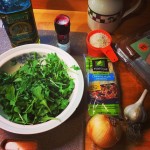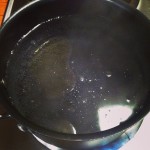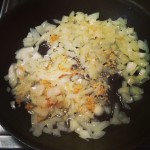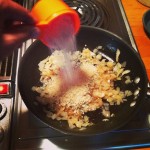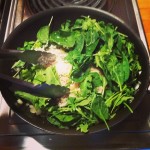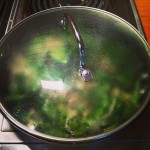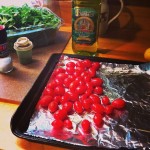This Meatless Monday, we feature arugula, with growing, storage and prep tips, as well as recipes for Arugula Pasta and Lemony Arugula Salad from Vermont Fresh: A Fruit and Vegetable Handbook.

Then toss them in with your pasta and arugula and voila! Instant color! Photo courtesy of Shannon Palmer.
Background
Arugula, also known as rugula, rucola, roquette, and garden rocket, is a leafy green with a flavor often described as “peppery” or “mustardy.” Native to the Mediterranean region, arugula is thought to have been enjoyed long ago by the Romans, who used the seeds for flavoring as well as eating the leaves. Arugula remains popular in Italian cuisine and is now cultivated in other temperate regions around the globe. Commonly found mixed into salads with other raw greens, arugula can also be lightly cooked. Because arugula is fairly hardy, it is often one of the first greens available in the spring. Although the green enjoys a somewhat upscale reputation, it is easy to grow and is often reasonably priced at farm stands and markets.
Growing Tips
Arugula is relatively cold-tolerant and grows best from spring to mid-summer. Heat can cause the leaves to be smaller and spicier. Direct-sow seeds in mid-spring, barely covering them with soil. Keep well watered. Leaves will be ready to harvest in only about a month! Floating row cover is very useful when growing arugula, which is very prone to attack by flea beetles (who will eat tiny holes in it, making it ugly though still perfectly edible). For a consistent crop of arugula, treat it like a lettuce mix and sow seeds every 3-4 weeks. If planting well into the summer, try to choose an area with partial shade. As plants mature, the flavor of the leaves becomes increasingly intense, so if you prefer a milder flavor, you may wish to harvest baby leaves. Most varieties of arugula will continue to produce for weeks if the leaves are picked individually. Arugula flowers are edible, too!
Storage
Like most greens, arugula deteriorates quickly after being picked. If you grow it yourself, avoid picking the leaves until just before you are ready to use them. Otherwise, arugula will keep for a few days when stored in a plastic bag in the refrigerator.
Nutritional Benefits
Despite being very low in calories (less than 10 per serving), arugula is packed with vitamins and minerals, including Vitamins A and K, folic acid, zinc, potassium, calcium, and iron. Folic acid is known to lower your risk of heart disease and even some types of cancer. Eating arugula is a great way to incorporate a wide variety of vitamins and minerals into your diet!
Preparation
Arugula is best when dark green, young, and tender. It can be eaten raw or cooked. Wash before using and dry in a salad spinner or by blotting gently with a clean towel. Try substituting arugula for spinach in some of your favorite recipes for an added kick! To cook arugula, sauté it lightly or add it to a dish right at the end of cooking.
Meatless Monday Recipe: Arugula Pasta
Shannon Palmer, a volunteer baking, tasting and testing recipes out of the Vermont Fresh Handbook tried out this recipe. Her comments and adjustments are in italics.
prep time: 10 mins | cooking time (8-15 mins)
serves 5
- I added roasted tomatoes for color and sweetness and parmesan to finish. (see below for roasting tomatoes). Photo courtesy of Shannon Palmer.
- I used a pack of Chinese Noodles (3 minute cook time), a box of dry pasta is less expensive choice (usually under $2.00). You can also use spinach in place of arugula in this recipe. Photos courtesy of Shannon Palmer.
- Cook pasta according to instructions. Salt water lightly and add splash of olive oil. When pasta is al dente, remove from heat and drain, reserving ¼ cup of the water. Put pasta in heavy serving dish, cover, and set aside. Photos courtesy of Shannon Palmer.
- Brown onion in oil; meanwhile, peel garlic cloves and finely chop garlic. Add to onion. Cook until garlic is light gold. Photo courtesy of Shannon Palmer.
- Add arugula, bread crumbs, and reserved pasta water. (I found you can really omit the breadcrumbs, they didn’t add much to the dish but more starch.) Photo courtesy of Shannon Palmer.
- Stir regularly until arugula has become wilted and very dark green. Photo courtesy of Shannon Palmer.
- I put the cover on to help steam the greens (about 3 mins)… Photo courtesy of Shannon Palmer.
- Roasting tomatoes is super easy and adds a nice touch of juicy sweetness. Simply preheat your oven to 400, lay some cherry tomatoes out, toss with a couple glugs of olive oil, 3-4 shakes of salt and pepper. Photo courtesy of Shannon Palmer.
- Roast them for about 10 minutes, just until they start to split open and get a little wrinkly. Warning, this may cause a bunch of steam/smoke so be careful opening the oven. Photo courtesy of Shannon Palmer.
- Then toss them in with your pasta and arugula and voila! Instant color! Photo courtesy of Shannon Palmer.
Ingredients
- 1 pound pasta
- ¼ cup olive oil
- 1 onion
- 3 cloves garlic
- 4 cups (approximately) coarsely chopped arugula
- ¼ – ½ cup dry bread crumbs (chopped dry/stale old bread works perfectly)
- Salt and pepper to taste
- Parmesan cheese (optional)
Instructions
- Cook pasta according to instructions. Salt water lightly and add splash of olive oil.
- While water is coming to a boil and pasta is cooking, heat olive oil in frying pan and dice onion.
- When pasta is al dente, remove from heat and drain, reserving ¼ cup of the water. Put pasta in heavy serving dish, cover, and set aside.
- Brown onion in oil; meanwhile, peel garlic cloves and finely chop garlic. Add to onion. Cook until garlic is light gold.
- Add arugula, bread crumbs, and reserved pasta water. Stir regularly until arugula has become wilted and very dark green.
- Combine mixture with pasta in serving dish. Add salt and pepper to taste and sprinkle with cheese if desired. Serve warm.
Note: for arugula with more tooth to it, toss it directly into your steaming hot and drained noodles (instead of sautéeing with onion etc.)… the heat from the noodles will wilt the greens more gently than sauteeing and will maintain a bit of the delicious crunch.
bon appetit!
Meatless Monday Recipe: Lemony Arugula Salad
Serves 2
(adapted from Tori Ritchie: Bon Appétit, April 2009, and epicurious.com)
Ingredients
- 4 cups arugula (smaller leaves are better for this)
- 1 large tomato, chopped
- ½ sweet onion, finely chopped
- 2 gloves of garlic, finely minced, or 1 teaspoon powdered garlic
- 1 lemon
- ¼ cup grated Parmesan cheese
- 4 tablespoons extra-virgin olive oil
- 2 teaspoons maple syrup or honey
- Pinch of salt and pepper
Instructions
- Combine arugula (chopped if the leaves are larger than bite-sized), tomato, onion, and garlic in large bowl.
- Using a fine grater, grate lemon peel until you have about 1 teaspoon of zest. Set aside, then squeeze 1 ½ tablespoons of juice from the lemon.
- Mix together lemon zest, lemon juice, Parmesan, olive oil, syrup or honey, salt, and pepper to make a dressing. For a smoother dressing, blend quickly in a food processor.
- Drizzle dressing over vegetables, toss, and serve.
Note: this salad is also great atop pasta or served with potatoes!
To receive more recipes and tips on your favorite fruits and vegetables, download Vermont Fresh: A Fruit and Vegetable Handbook. We also need more volunteer home chefs for this project.
Vermont Foodbank fresh food initiatives would not be possible without your support. Please consider giving to the Vermont Foodbank today!


